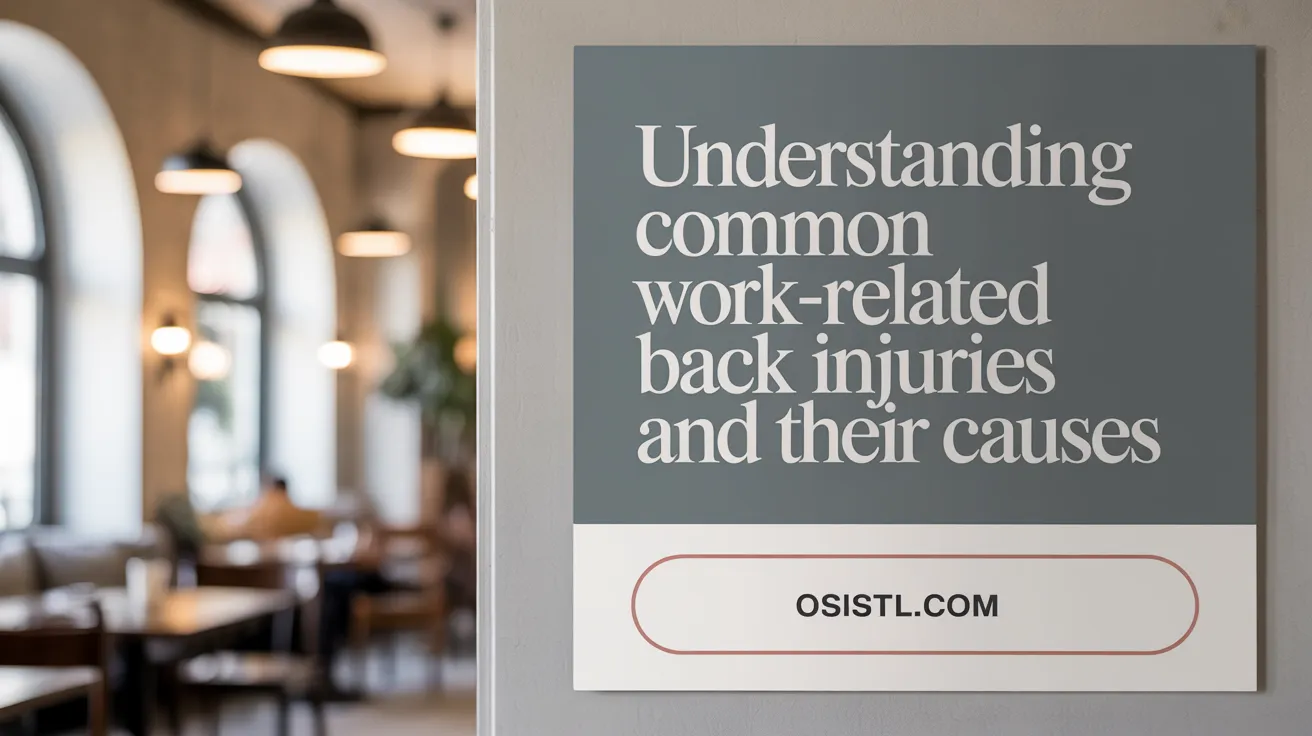Introduction to Workers’ Comp Back Injuries and Treatment Options
Back injuries are among the most common and challenging workplace injuries, accounting for a significant portion of workers' compensation claims annually. These injuries range from muscle strains to severe spinal cord trauma, often resulting from improper lifting, repetitive tasks, slips, falls, or vehicle accidents. Understanding the treatment options available within the workers’ compensation system is critical for optimizing recovery, reducing disability, and ensuring appropriate benefits coverage. This article explores the spectrum of treatment strategies, benefits, and legal considerations for workers suffering back injuries covered under workers' compensation.
Common Types of Work-Related Back Injuries and Their Causes

What kinds of back injuries do workers typically suffer on the job?
Workers frequently suffer various back injuries including muscle strains, lumbar sprains, herniated or bulging discs, fractured vertebrae, spinal cord injuries, and degenerative disc conditions aggravated by workplace activities. These injuries can affect muscles, ligaments, discs, and nerves, leading to pain and functional limitations. See more on Common work-related back injuries.
What are the primary causes of workplace back injuries?
The main causes of back injuries at work include improper lifting techniques, repetitive twisting or turning, overexertion, slips and falls, vehicle accidents, and whole body vibration exposure. Sudden traumatic events or repetitive strain from daily tasks often trigger these injuries. Learn about Causes of back injuries at work and Causes of Work-Related Spinal Cord Injuries.
Which jobs are at higher risk for back injuries?
Occupations with heavy physical demands or frequent lifting carry a higher risk of back injuries. This includes construction workers, nursing assistants, warehouse workers, truck drivers, landscapers, roofers, and movers. These roles often involve heavy loads or repetitive motions that strain the back. Refer to High-Risk Jobs for Back and Neck Injuries and Workers' Compensation for Construction Back Injuries.
How common are back injuries in the workers’ compensation system?
Back injuries represent roughly 20% of all workplace injuries and illnesses covered by workers’ compensation. More than a million U.S. workers sustain work-related back injuries each year, making them one of the leading causes of comp claims. These injuries are costly due to treatment needs and time lost from work. For comprehensive details, see Workers' Compensation for Back Injuries overview, Workers' compensation benefits, and Workplace Back Injury Statistics.
Conservative Treatment Options: Physical Therapy and Pain Management

Role of physical therapy in workers’ comp back injury treatment
Physical therapy plays a vital role in treating work-related back injuries within the workers' compensation system. It focuses on relieving pain, reducing inflammation, restoring mobility, and promoting faster healing. By addressing these issues, physical therapy enables injured workers to return to work after injury sooner and helps prevent future back injuries.
Common therapy techniques and modalities
Common physical therapy methods include manual therapy for injury recovery, therapeutic exercises for work injuries, postural retraining benefits, dry needling treatment, and work hardening programs aimed at safely increasing strength and endurance for work tasks. These approaches are often combined for a comprehensive treatment plan.
Pain management strategies including medications
Pain management typically involves medications such as NSAIDs as the first line of treatment, along with acetaminophen for additional relief. Muscle relaxants may be prescribed for short periods to manage spasms. Opioids are reserved for severe pain and are used cautiously with strict monitoring, following workers' compensation pain medication guidelines.
Benefits of conservative care and avoiding surgery when possible
Conservative treatments like physical therapy and medication management often reduce the need for invasive procedures such as lumbar decompression surgery. Early and appropriate conservative care effectively controls symptoms and improves function, lowering the likelihood of surgery such as spinal fusion surgery. This approach supports a safer, more accessible recovery for injured workers.
| Treatment Aspect | Examples | Benefits |
|---|---|---|
| Physical Therapy Methods | Manual therapy, postural retraining, dry needling, work hardening | Pain relief, mobility restoration, injury prevention |
| Pain Medications | NSAIDs, acetaminophen, muscle relaxants, limited opioids | Symptom control, inflammation reduction |
| Conservative Care Focus | Non-invasive treatments before surgery | Avoids risks and costs of surgery, promotes recovery |
Advanced Medical Interventions: Injections and Surgical Options

When are injections or surgery considered for workers’ comp back injuries?
Epidural steroid injections and nerve root blocks are commonly employed when initial conservative treatments like physical therapy for back pain or medication do not sufficiently reduce pain. These injections aim to decrease inflammation and provide targeted relief.
Surgery, including procedures such as lumbar decompression surgery or spinal fusion surgery, is reserved for severe or persistent cases where non-surgical methods have failed, or when structural damage threatens neurological function. Refer to the Mid and Low Back Injury Treatment Guidelines for detailed protocols.
What are the medical guidelines for surgical intervention?
Medical treatment guidelines advocate for a structured, patient-centered approach. Treatment begins with conservative methods and escalates to minimally invasive surgery only when necessary. This progression ensures surgeries are evidence-based and performed within recommended timelines to maximize benefit and reduce risks.
How important is individualized treatment planning for surgery?
Individualized treatment planning is essential. Each patient’s injury severity, response to therapy, and overall functionality are carefully evaluated to design a plan that promotes optimal recovery. This personalized strategy helps enhance return-to-work outcomes and prevents unnecessary procedures.
Common Interventions Overview
| Intervention Type | When Used | Goal |
|---|---|---|
| Epidural Steroid Injections | Failed conservative treatment | Pain reduction & inflammation control (Pain management after a work injury) |
| Nerve Root Blocks | Specific nerve pain with radiculopathy | Targeted nerve relief |
| Lumbar Decompression Surgery | Severe nerve compression or structural issues | Relieve pressure, restore function (Mid and Low Back Injury Treatment Guidelines) |
| Spinal Fusion Surgery | Instability or severe degenerative changes | Stabilize spine |
Legal and Benefit Aspects of Workers’ Compensation for Back Injuries

What benefits are provided under workers' compensation for back injuries?
Workers' compensation insurance provides a comprehensive safety net for workers suffering back injuries on the job. Benefits include coverage for medical treatments—ranging from emergency care, diagnostics like MRIs, rehabilitation services, medications, injections, and surgeries—to wage replacement during recovery. Workers may also receive disability benefits based on the severity and permanence of the injury, including temporary partial, temporary total, permanent partial, or permanent total disability payments. In severe cases, death benefits may be available to survivors. For more details, see Workers' compensation insurance program, Medical Treatment Guidelines, and Workers' compensation benefits in New York.
How should injured workers report and file claims for back injuries?
Prompt reporting is critical. Injured workers should immediately inform their supervisor or the HR department about the injury to ensure proper documentation. Filing a claim typically involves submitting designated forms within state-specific statutory deadlines, often within a year of the injury. Thorough medical documentation, including doctor’s notes, diagnostic test results, and treatment plans, supports the legitimacy of the claim. For guidance, visit Immediate reporting of workplace back injuries and Reporting a workers' compensation injury.
What factors affect the approval or denial of back injury claims?
Several issues can lead to claim denial. These include evidence that the injury stems from a pre-existing condition rather than the current work event, missing filing deadlines, absence of witnesses, disputes over whether the injury occurred during employment, or insufficient medical proof linking the injury to work activities. For more on challenges in claims, see Common reasons for workers' comp claim denial and Factors Affecting Settlement Values.
What options do workers have if a claim is denied or disputed?
Workers have the right to appeal denied claims through informal or formal review processes. Obtaining legal assistance from workers' compensation attorneys is often beneficial. Experienced lawyers help gather evidence, ensure timely filings, negotiate benefits, and navigate the complex legal procedures involved in claims and appeals, significantly improving injured workers’ chances of receiving deserved benefits. For legal guidance, see Legal advice for workers' comp claims, Workers' compensation claim process, and Consulting workers’ compensation attorney.
Preventive Strategies and Workplace Ergonomics to Reduce Back Injuries

How can workplace back injuries be prevented?
Back injuries at work are largely preventable by adopting several simple yet effective strategies. Key prevention techniques include using proper lifting techniques , such as bending the knees and using the legs rather than the back to lift heavy objects. Ergonomics for Back Injury Prevention plays a vital role by modifying workstations to fit workers' needs and reduce strain. Stretching and warming up for back health prepare muscles and may decrease injury risk. The use of mechanical aids for back safety like forklifts, dollies, or hoists can lighten loads and reduce manual handling. Additionally, training workers to recognize and manage recognizing repetitive tasks and awkward postures helps minimize cumulative damage.
What role do physical therapists play in prevention?
Physical therapists are central to workplace injury prevention. They perform detailed ergonomic evaluations to identify risk factors in work processes and environments. Through retraining, they teach workers safe movement patterns and postural retraining benefits to reduce stress on the back. Physical therapists also design work hardening programs customized to the worker’s job demands, helping to rebuild strength and endurance without risking re-injury. This proactive approach supports a faster and safer return to work and helps prevent recurring injuries.
Why is early intervention important in back injury prevention?
Early intervention is crucial in managing back injuries effectively. Recognizing initial symptoms of pain and addressing them promptly can halt progression into more serious conditions. Early action reduces the likelihood of prolonged disability, minimizes lost work time, and facilitates quicker recovery. Awareness campaigns to educate workers on early signs of injury and the importance of reporting symptoms immediately empower employees to seek care promptly. Combined with ergonomic evaluations and physical therapy for back pain, early intervention significantly lowers the burden of workplace back injuries.
Managing Recovery and Maximizing Workers’ Compensation Benefits
What should injured workers do to maximize workers' comp benefits?
To ensure the best outcome from workers' compensation benefits, injured workers need to stay proactive throughout their recovery. This includes attending all scheduled medical appointments and strictly following prescribed Work injuries treatment options. Open communication with doctors about symptoms and progress is vital to adapt treatments as needed and support recovery.
How important is documentation in supporting a workers' comp back injury claim?
Accurate and thorough documentation plays a crucial role in workers' compensation claims for back injuries. Medical records, diagnostic imaging like MRIs or X-rays, and detailed reports describing the injury event help establish the injury's legitimacy. Maintaining these documents, along with logs of treatment progress and impacts on work capacity, strengthens the claim and influences workers' compensation benefits, or settlement amounts.
When might legal assistance be necessary?
Legal counsel can be an essential resource when navigating complex or contested workers' compensation claims. Injured workers may require legal help if claims are denied or disputed, during settlement negotiations, or if they face challenges in accessing appropriate treatment or fair compensation. Lawyers familiar with workers’ comp law can advocate for rights and guide injured workers through legal procedures.
How long can workers' comp benefits last for back injuries?
The duration of workers' compensation benefits varies significantly. Some back injuries heal with relatively short recovery time, while others may require extensive ongoing treatment lasting months or years. Depending on state laws and injury severity, benefits may include temporary disability payments or permanent disability compensation with coverage continuing for long-term or lifelong needs.
Maintaining treatment adherence, detailed communication with healthcare providers, and knowing when to seek legal support can greatly improve recovery outcomes and the successful resolution of workers' compensation claims related to back injuries.
Conclusion: Navigating Treatment and Benefits for Back Injuries in the Workplace
Back injuries sustained at work pose multifaceted challenges requiring coordinated medical, legal, and workplace management approaches. Conservative treatments such as physical therapy and pain management form the cornerstone of care, with advanced interventions reserved for more severe cases. A comprehensive understanding of workers’ compensation benefits and the importance of timely reporting and documentation is vital for injured workers. Preventive strategies and ergonomic interventions can significantly reduce injury risk and recurrence. Ultimately, adherence to treatment, open communication with healthcare providers, and access to legal support when necessary empower workers to achieve optimal recovery and fair compensation within the workers' compensation framework.
